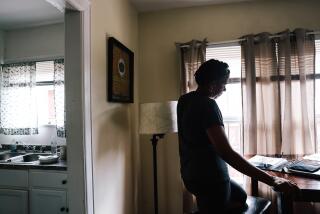Prosecutor outlines case against man in three South L.A. slayings
The half-naked bodies were found amid filth and debris. One of the dead women was dumped in a back alley. Another was in a parking lot dumpster. A third was in an abandoned commercial garage.
All were within a few miles of each other in South Los Angeles, their necks displaying the same tell-tale signs of a slow, painful strangulation.
On Monday, 2 1/2 decades after the bodies were found, a prosecutor told jurors the women were all victims of Samuel Little, now a silver-haired 74-year-old who sat silently in a wheelchair as his murder trial began in a downtown L.A. courtroom.
Deputy Dist. Atty. Beth Silverman described Little as a ruthless sexual deviant who preyed on vulnerable women down on their luck. She said he had also carried out similar attacks in Mississippi and San Diego before committing the Los Angeles slayings, often targeting women who were working as prostitutes or had drug habits.
“They were women who had lost their way,” Silverman said. “Easy targets for a calculated killer who was looking to prey on women.”
Cold-case homicide detectives connected Little to the 1987 and 1989 deaths through DNA evidence in 2012. They matched genetic material found under one woman’s fingernails and on semen staining two of the women’s shirts to Little, who was then living in Kentucky.
The prosecutor told jurors they will hear testimony from women who survived Little’s attacks before the South L.A. slayings and would see for themselves how the assaults followed a similar pattern.
She said Little’s trail of assaults began nearly a decade before the South L.A. murders. In Mississippi during the summer of 1980, he allegedly went to the home of a woman who was working as a prostitute and punched her, knocking her out, Silverman said. He later attempted to drown the woman in her bathtub, the prosecutor said.
The next year, a single mother of three was hired by Little as a prostitute but beaten and choked in his car before she managed to escape, Silverman told jurors. The woman didn’t report the assault to authorities for a couple of years, she said.
“She didn’t think anybody would care,” Silverman said. “She was a black prostitute, in the South, in the early ‘80s.”
By the mid-1980s, Little was in San Diego when a woman reported to the city’s police that Little had pulled her into his black Thunderbird, sexually assaulted her, then repeatedly choked her unconscious. She awoke to find herself lying, probably left for dead, amid trash and broken glass with bruising on her neck and popped blood vessels in her eyes, Silverman said.
A month later, Little was caught in the act, the prosecutor said. Three patrol officers came across a parked black Thurnderbird, from which they saw Little emerge zipping up his pants. He told officers he’d just had a fight with his wife but they were making up, Silverman said. When the officers shined their light into the car, they saw an unconscious woman awkwardly slumped in the back seat, bleeding from her nose and mouth, Silverman said. The victim had been severely beaten and choked, the prosecutor told jurors.
While he was being taken into custody, Little complained to officers that the woman “hadn’t given him his money’s worth,” Silverman said.
Little was convicted of false imprisonment and felony assault, but was released after serving 2 1/2 years. It was in July 1987, shortly after his release, that the first of the bodies was found in Los Angeles. The victim was Carol Alford. In 1989, the bodies of Audrey Nelson and Guadalupe Abodaca were found. At the time, Little was living with his girlfriend within five to eight miles of the crime scenes, Silverman said.
Little’s attorney, Deputy Public Defender Michael Pentz, countered that most of the “disturbing” story told by the prosecutor about Little’s past had nothing to do with the charges his client was now facing. The DNA evidence, he said, will show Little had “nothing to do” with the deaths.
Police have said Little, who also used the name Samuel McDowell, committed crimes in 24 states but served relatively little time behind bars. Little’s DNA information has been shared with law enforcement in different parts of the country to use in other unsolved death cases. Silverman said she was unaware of any pending charges elsewhere.
More to Read
Start your day right
Sign up for Essential California for news, features and recommendations from the L.A. Times and beyond in your inbox six days a week.
You may occasionally receive promotional content from the Los Angeles Times.







